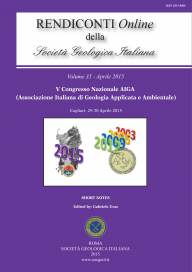
The local seismic response of the Fosso di Vallerano valley (Rome, Italy) based on a high-resolution geological model
Francesca Bozzano (a), Fabrizio Marra (b), Salvatore Martino (a), Antonella Paciello (c), Gabriele Scarascia Mugnozza (a) & Chiara Varone (a)
(a) Sapienza Università di Roma – Dipartimento di Scienze della Terra e Centro di Ricerca CERI - Piazzale Aldo Moro, 5, 00185, Roma, Italia. E-mail: chiara.varone@uniroma1.it
(b) Istituto Nazionale di Geofisica e Vulcanologia, Via di Vigna Murata, 605, I-00143 Roma, Italia.
(c) Agenzia Nazionale per le nuove tecnologie, l'energia e lo sviluppo economico sostenibile (ENEA-Casaccia) - Via Anguillarese, 301, 00123, Roma, Italia.
Volume: 35/2015
Pages: 29-32
Abstract
The main purpose of this study is the analysis of the local seismic response in the Fosso di Vallerano valley, an alluvial basin located in a recently urbanized area of Rome (Italy). A high-resolution geological model was obtained starting from 250 available borehole log stratigraphies and pressiometer in-site tests; the model highlighted a complex and heterogeneous setting of both the local substratum and the alluvial fill. The local seismo-stratigraphy was derived based on several noise measurements as well as one cross-hole test. A preliminary validation of the stratigraphic model was performed by modeling the amplification functions (SSR) derived from weak motions recorded on August 2009 through a temporary velocimetric array. The obtained results show that the recent alluvial deposits have one principal mode of vibration at about 0.8 Hz and different secondary vibrational modes due to the characteristic stratigraphic setting of the alluvia. The seismic bedrock can be located within the Paleo Tiber 4 deposits (Santa Cecilia Formation) by assuming a velocity gradient in these deposits (i.e. corresponding to the Vs increment from about 500 m/s up to 1100 m/s).
Keywords
Get Full Text